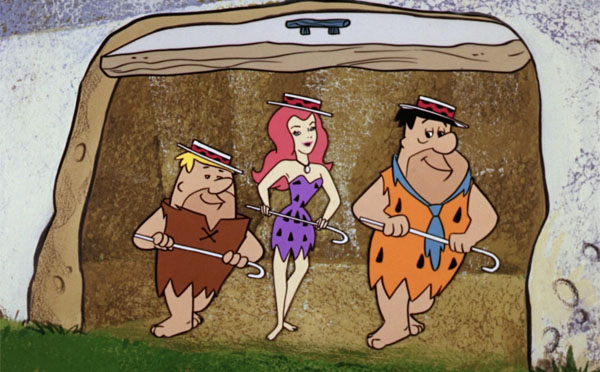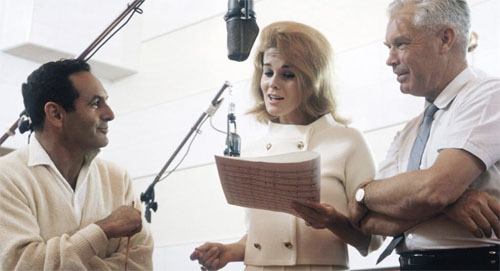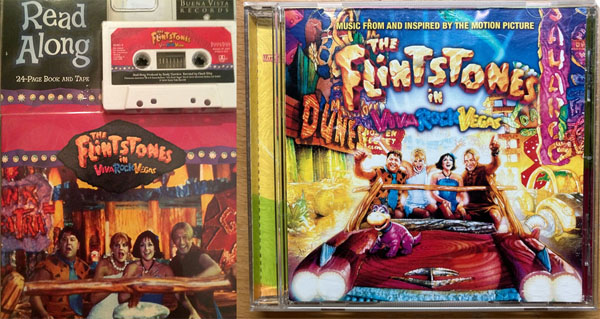The spectacular Ann-Margret babysat for Pebbles, danced with Fred and Barney, and generally made the sixties extra super groovy.

Ann-Margret Olsson, who turned an enchanting 82 this year, charmed and enticed the film, TV, recording, and live entertainment industries, and still fires up the road on her Harley-Davidson. Billed early in her career as “the female Elvis,” she and Presley ignited the screen in the 1964 hit, Viva Las Vegas, where she danced in the distinctive style that inspired Saturday Night Live’s Kristen Wiig.
There is an enigmatic duality to Ann-Margret’s persona that is among the reasons she has fascinated audiences for generations. She is the shy, demure girl next door in the narrative portions of the 1963 film version of the Broadway musical, Bye Bye Birdie, as well as the alluring, sizzling extrovert in the “A Lot of Livin’ to Do” dance sequence, as well as the film’s title song bookend sequences. Ann-Margret herself has expressed the dichotomy in various interviews.
This was evidenced in her animated debut on the fourth season premiere episode of The Flintstones, “Ann-Margrock Presents.” Her cartoon counterpart, designed by Jonny Quest’s creative beacon Doug Wildey, was essentially split into a dual role as a sweet babysitter out of nowhere named “Annie,” and the “big star who is really nice in real life” who does a big TV special in Bedrock. Her versatility is further emphasized when her cartoon agent (voice of Howard Morris), twice exclaims, “She can do ANY kind of music!”
Two songs were written for the episode, but never officially released on records. “Annie” sings the gentle, tender “The Littlest Lamb” to lull Pebbles to sleep.
Once her identity is revealed, superstar Ann-Margrock brings down the house with the sassy “I Ain’t Gonna Be Your Fool.” According to H-B historian Earl Kress, both songs were recorded in stereo and were planned for Rhino’s “Modern Stone-Age Melodies” Flintstones soundtrack CD, but final approval was not granted. The mono version of “Lamb,” direct from the finished film, and the stereo version of “Fool” were both released in Germany by the Bear Family label in a boxed CD set called Ann-Margret 1961-1966.
The episode itself was rocketed into production ahead of schedule. It was slated for later in season four, but ABC asked for it to be completed in time for the September premiere week. Lots of attention was given to Ann-Margret’s involvement in the production, including a photo spread showing her visit to the H-B studios on Cahuenga Blvd.

Joe Barbera, Ann-Margret and Bill Hanna
Her appearance on The Flintstones is almost as much of a Columbia/Screen Gems crossover as Elizabeth Montgomery and Dick York’s participation in The Flintstones “Samantha” episode. Director George Sidney, whose association with Hanna and Barbera dates back to the stunning live-action/animated dance with Gene Kelly and Jerry the mouse in 1945’s Anchors Aweigh, was a business partner with Hanna-Barbera Productions. He and his father Louis K. Sidney were instrumental in helping H and B survive at MGM in the waning days of animated shorts and with their forays into TV animation.
Sidney was the director of Bye Bye Birdie, and there are H-B touches throughout much of the film. In “The Telephone Hour,” the Colpix Yogi Bear soundtrack album is clearly visible in one of the teen’s rooms.
During “How Lovely to Be a Woman,” Hanna-Barbera toys grace Kim McAfee’s room.
Bye Bye Birdie also contains animation, most likely from the H-B artists, including a “melting” ending to “The Telephone Hour” and cartoon happy faces for Dick Van Dyke and Janet Leigh for the song, “Put on a Happy Face” (Van Dyke’s first interaction with animation came as the on-camera host of CBS Cartoon Theater, a 1956 network summer replacement series – with Van Dyke as host, who would interact with Terrytoon co-stars via a television in his studio. Birdie marked Van Dyke’s first animation/live-action movie sequence, albeit not as elaborate as the one in Mary Poppins a year later). Even the pink outfit Ann-Margret wears in “A Lot of Livin’ to Do” bears a resemblance to Judy Jetson’s groovy outfit.
Three decades later, Universal produced a sequel to Steven Spielberg’s blockbuster live-action version of The Flintstones with a smaller budget and less hoopla. The Flintstones in Viva Rock Vegas, with its smaller budget and reduced media support, received mixed reviews and was not as successful as its predecessor, yet some found it slightly more faithful to the original series. Loosely based on the episodes “Honeyrock Hotel” and “The Gambler,” it concludes with the wedding of Fred and Wilma (note John Stephenson dubbing the minister) and the splashy “Viva Rock Vegas” song parody.
To bring things full circle, Ann-Margret herself recorded “Viva Rock Vegas” for the end credits and the soundtrack album. Director Brian Levant told Frank Santopadre and Gilbert Gottfried on their “Amazing Colossal” podcast visiting her home and seeing that she had an “Ann-Margrock” animation cel on display.
“The Flintstones in Viva Rock Vegas”
This read-along recording featuring soundtrack dialogue and script adaptation by yours truly was licensed and produced by Walt Disney Records for their Buena Vista label (as was Jim Carrey’s How the Grinch Stole Christmas). It is the only Disney-produced recording that features a Hanna-Barbera sound effect, provided for the page-turning signal.



 GREG EHRBAR is a freelance writer/producer for television, advertising, books, theme parks and stage. Greg has worked on content for such studios as Disney, Warner and Universal, with some of Hollywood’s biggest stars. His numerous books include Mouse Tracks: The Story of Walt Disney Records (with Tim Hollis). Visit
GREG EHRBAR is a freelance writer/producer for television, advertising, books, theme parks and stage. Greg has worked on content for such studios as Disney, Warner and Universal, with some of Hollywood’s biggest stars. His numerous books include Mouse Tracks: The Story of Walt Disney Records (with Tim Hollis). Visit 





















































Ann-Margret described her “enigmatic duality” best in her 1994 autobiography as “from Little Miss Lollipop to Sexpot-Banshee.” I like both sides of her. In fact, she’s incredible from every angle.
It’s funny that H-B never released a record of the two songs Ann-Margret sang in the Flintstones episode she was in, because as it happens “Viva Las Vegas”, which was also directed by George Sidney, never had an official soundtrack album despite its being Elvis Presley’s highest grossing film. As I understand it, Elvis’s manager, Col. Tom Parker, refused to release a soundtrack album unless Elvis was given sole starting credit before the film’s title. Sidney refused. That’s why the Colonel doesn’t have his usual “Technical Advisor” credit.
I wonder if the decision not to release those songs on record might have been Ann-Margret’s own. At this point in her career, she was anxious to move beyond musicals and prove herself as a serious dramatic actress. Her very next film after “Viva Las Vegas” was a black-and-white film noir called “Kitten with a Whip”, which I’ve never seen, but something tells me it isn’t as good as it sounds.
Kim McAfee has one of those weird Barney Rubble figures with the green hair and green toenails. I think Steve Stanchfield has one of those, too.
I was familiar with Ann-Margrock and Stony Curtis before I knew of their real-life counterparts. I loved the Flintstones’ musical episodes, as well as their clever show business parodies; hell, I even loved the Great Gazoo, as far as that goes. Thanks for this look back at a couple of childhood favourites — The Flintstones and Ann-Margret — both of which I came to appreciate on a higher level as I grew into adolescence and adulthood.
Now it’s time for this little lamb to hit the hay. Good night!
I’ve never seen it straight, but ‘Kitten With a Whip’ was included on an episode of Mystery Science Theater 3000, one of my favorite shows and this movie gave them some of their best material.
It’s a typical ‘juvenile delinquents raise heck’ picture, with Margret escaping from juvie and invading the home of a political prospect whose wife and child are conveniently away. She then invites some hepcats to come and take over the house. It’s totally ridiculous, and a hoot if you’re in the right frame of mind.
It’s not a WB picture, but at one point Margret is watching TV and ‘Canned Feud’ with Sylvester is playing.
There is a dimensionality to the episode “Ann-Margrock Presents” which wouldn’t have been possible at the top of Season Three. The episode probes a family-friendly atmosphere through the “Littlest Lamb” sequence of a caliber that has never before been seen on “The Flintstones” and would certainly not have characterized its parent series “The Honeymooners.” Now that Fred and Wilma have a family, that family ambiance comes front and center in this episode, which is in some ways milder and in other ways edgier (due perhaps to the above-referenced dichotomy regarding the guest star herself) than anything that has come before in the series. With this episode in particular, the Flintstones becomes more than a sitcom parody with a stone-age setting, and the characters exhibit genuine feelings for each other. The bond between Annie and Pebbles is palpable and even the friendship of Fred and Barney seems more solid than ever. This dynamic has been implicit all along, but here it takes center stage.
Ann-Margrock also around this time made an appearance in the comic books. In Gold Key’s issue #17, Ann gets romantically involved with Fred’s beatnik nephew Rodney Rocktop in a story that slightly parallels its TV counterpart but soon goes its own way. In a delightful touch, she is in Bedrock to promote the premiere of her latest film, “Bye Bye Bronto.”
Ann-Margret’s connection to the Flintstones may have been occasional and brief, but whenever she interacted with Hanna-Barbera the results were pure gold.
Since HB was affiliated with Columbia Pictures, is it possible those “Bye Bye Birdie” product placements came from the studio rather than Sidney himself? Might be worth keeping an eye out when viewing other Columbia films and shows of the era.
In 1969 Dick Van Dyke starred in “The Comic”, about the rise and fall of a silent comedian produced by Columbia. At one point the now-elderly man putters around his apartment as an ancient Columbia Krazy Kat short plays on the television.
Anything with Ann-Margaret is worth watching.
Kim McAfee (Ann-Margret)’s bedroom in “Bye Bye Birdie” is also adorned with Fred and Barney figurines, and her little brother wears Huckleberry Hound pajamas. Another Columbia film made around the same time, William Castle’s “Straitjacket,” starring Joan Crawford, displays a case of Pepsi prominently on a kitchen counter. And they complain about product placement in today’s movies!
I’ve been waiting for someone else to bring this up, but there’s another Ann-Margret / animation connection—In the aforementioned Kitten with a Whip, there’s a scene with the 1951 Sylvester cartoon, Canned Feud on a TV in the background (Even though the film was released by Universal!).